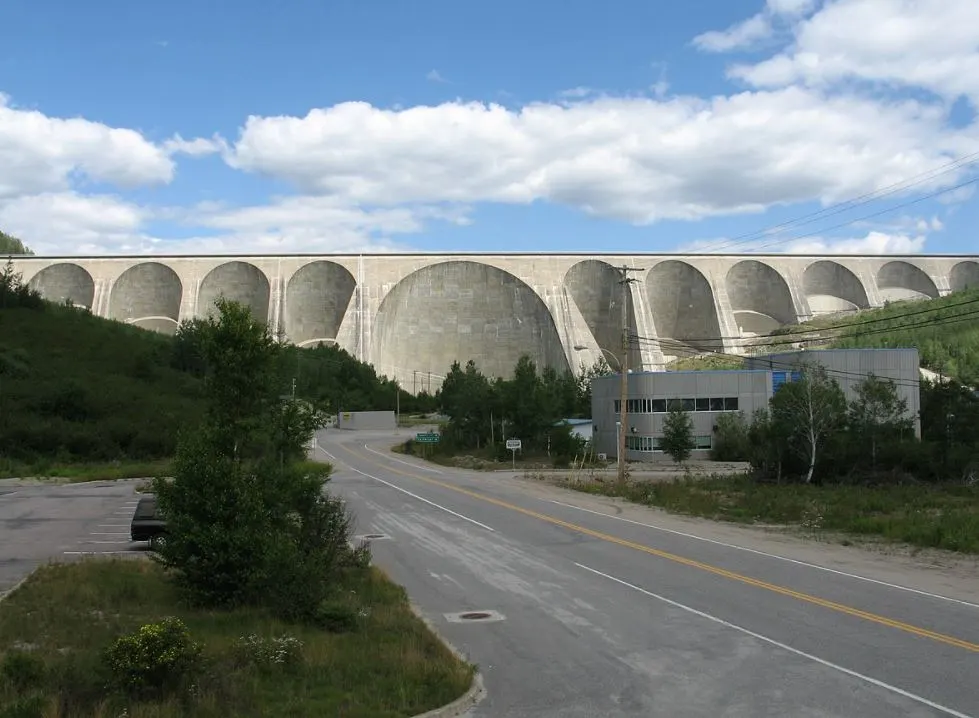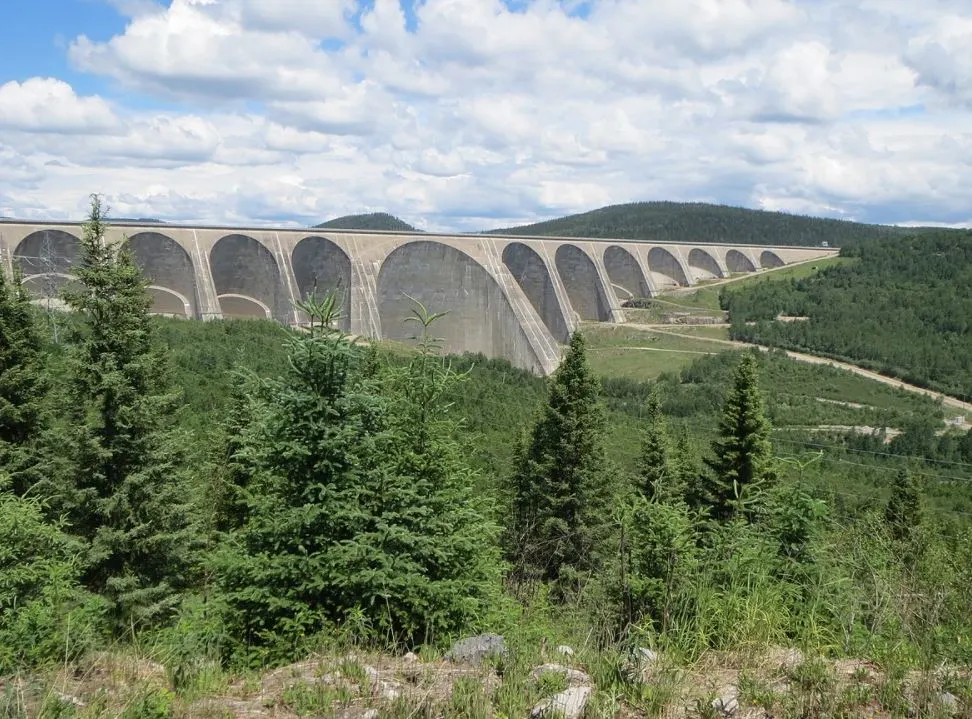One of the most astounding dams in the world can be found in the wilderness of Quebec in Canada.
In this article, we’ll take a closer look at some interesting facts about the Daniel-Johnson Dam, also known as the “Barrage Manic-5.”
1. The dam is located in the middle of nowhere in Quebec
The Daniel-Johnson Dam or “Barrage Daniel-Johnson” was originally known as Manic-5 and is an enormous dam located in the wilderness of the Canadian province of Quebec.
The small town of Baie-Comeau on the Saint Lawrence River is located about 214 kilometers (133 miles) to the south of the dam. You need to travel another 420 kilometers (260 miles) to reach the first major city in the region, Quebec City, the capital city of the province.
This means that the dam is located in an uninhabited piece of nature on the Manicouagan River. This river originates just north of the dam and flows all the way to the small town of Baie-Comeau into the Saint Lawrence River.

2. It’s located near a reservoir formed by an impact crater
The Manicouagan River originates flows all through the Côte-Nord region of Quebec and originates in the Manicouagan Reservoir, one of the most remarkable bodies of water on the planet!
This reservoir is a huge impact crater lake that covers a total area of 1,942 square kilometers (750 square miles). It was formed in the Late Triassic Period, approximately 214 million years ago, when a huge meteorite collided with the Earth.
The lake, which is also referred to as the “Eye of Quebec,” completely surrounds René-Levasseur Island, the second-largest lake island in the world (total area of 2,020 square kilometers / 780 square miles) after Manitoulin Island in Lake Huron.
This fascinating island was named after René Levasseur, the chief engineer of the Daniel-Johnson Dam who passed away at the age of 35, just days before the dam was officially inaugurated.

3. The original studies to build a dam date back to the late 1910s

The Manicouagan River is one of the major rivers in the area and its power has been recognized since at least the early 20th century. The first hydrological studies were conducted in the summers of the years 1919 and 1920, shortly after World War I.
Because the river is located in such a desolate piece of nature without any roads leading to it, building a dam at this point was considered to be unfeasible.
The studies were deemed more than positive, though, with a combined flow of over 40 million cubic meters. It wasn’t until the discovery of iron deposits in the region that the region was developed and roads were built.
This in combination with newly developed technology to transport large amounts of electricity over long distances resulted in new studies being conducted in the 1950s to build multiple dams in the region.

4. It took 9 years to build the enormous dam
The new studies started in 1955 and were commissioned by Hydro-Québec. What was supposed to be a 5-year study resulted in such positive initial conclusions of the region’s potential that the company didn’t wait until the study was completed.
The construction of the dam referred to back then as “Manic-5,” already started in the year 1959. The design was made by French civil engineer André Coyne and turned out to be a multiple arch buttress dam that was completed in 1968, just 9 years after construction had started.
Diverting the Manicouagan River to build the dam was an enormous endeavor. 2 massive tunnels with a length of 610 meters (2,000 feet) and a diameter of 14 meters (45 feet) were dug.
In order to achieve this, 2 huge cofferdams were built with a pit in between that had a depth of 46 meters (150 feet). Once the water was pumped out, this pit was filled with concrete to serve as the foundation of the enormous dam.

5. It’s the largest dam of its kind in the world
The Daniel-Johnson Dam is an enormous structure and the largest multiple arch buttress dam in the world. Here are some interesting facts about this huge dam:
- Height: 214 meters (702 feet).
- Length: 1,314 meters (4,311 feet)
- Width (base): 22.5 meters (74 feet)
- Width (top): 3 meters (10 feet)
- Volume (concrete): 2,200,000 cubic meters (2,900,000 cubic yards)
- Turbine capacity: 1,596 MW (Manic-5) / 1,064 MW (Manic-5-PA)

6. It’s not the only dam that was built in the area
During the 1950s, 1960s, and 1970s, multiple dams were eventually built on the Manicouagan and the Outardes rivers. Some of these dams are referred to as Manic-1, Manic-2, Manic-3, and Manic-5, Outardes-2, Outardes-3, and Outardes-4.
Manic-4 was canceled early on because it would interfere with the power of Manic-3.

7. The dam was named after the man who started the project
The original name of the dam was “Manic-5,” a reference to the river it was built on. The dam was renamed, however, to the “Daniel-Johnson Dam” in the year 1969, a reference to the man who set the entire project in motion in the 1950s.
Daniel Johnson Sr. (1915-1968) was the 20th Premier of Quebec and served as a minister in the Canadian government. He suddenly died on September 26, 1968, the day following the opening ceremony of the dam which was attended by numerous high-ranking politicians.
His sudden death from a heart attack in that particular moment resulted in the dedication ceremony the following day being canceled. Exactly 1 year later, the official dedication ceremony was conducted, a plaque was unveiled, and the dam was renamed in Johnson’s honor.

8. It has been a popular tourist attraction since the 1960s
One of the most remarkable facts about the Daniel-Johnson Dam is that ever since it opened, it has been a popular tourist attraction regardless of its location in a relatively uninhabited area.
Guided tours are conducted 4 times a day by employees of Hydro-Québec in which visitors can learn everything about this amazing structure, including all the details about its construction and operations.

